How to choose and correctly connect a three-key switch
In an effort to improve the convenience of controlling electrical appliances, manufacturers are creating new types of functional devices. One of these is a triple switch.
We will consider in more detail what design the three-key switch has and what nuances to consider when connecting the device.
The content of the article:
Three-key switch design
Switches of this type with standard dimensions of devices are equipped with three keys located close to each other. Their main purpose is to provide the ability to simultaneously control three groups of connected lighting devices from one common access point.
Most often, such devices are installed in rooms with a complex configuration: combined bathrooms, long corridors combined with living room kitchens.
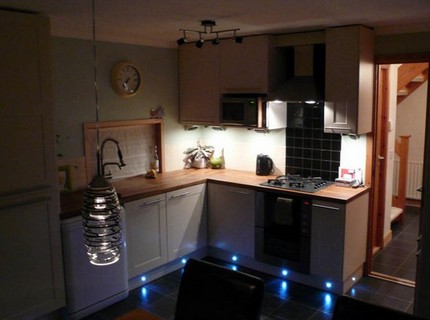
Three-key devices are convenient for controlling multi-track chandeliers. To obtain three options for saturated light, they can be included in three stages, in which first one lamp lights up, then the next two.
Among the indisputable advantages of three-circuit devices include:
- Presentable appearance.
- Space saving.
- Easy installation.
Simplification of the installation procedure of the three-key switch is achieved by reducing labor costs when creating a common technological niche for placing the core of the device and laying an electric cable to it.
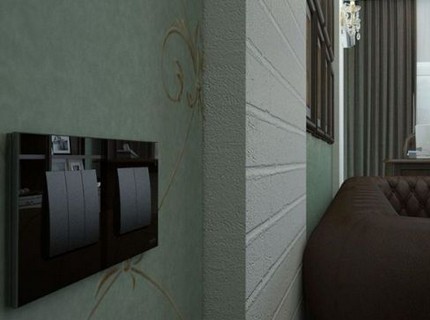
The design of the three-key switch is quite simple and includes two components:
- The inner part, which is a movable mechanism, where the process of closing / opening the network under the action of compression / extension of the spring.
- The outer part, which is a box with a switch key, to which the contacts are permanently attached.
Since the load on such devices is somewhat higher in comparison with simple types of models, the internal elements and the external case are made only of high-quality materials.
The main types of closing devices
Switches, including triple, depending on the control method, there are keyboard and touch performance. The first are set in motion by pressing a key, the second - by touching the panel in a specific place.

When choosing a dimmer, it is important to focus on the total load of the switch. Experts recommend purchasing devices with a power reserve. For example: for a three-arm chandelier with lamps within 100 watts, choose a dimmer that has a marking of 300 W.
Read more about what a dimmer is and how to choose it, see this stuff.
Depending on the type of installation, triple switches are of three types:
- for outdoor installation;
- internal, involving deepening into the cavity of the wall;
- combined models having a common housing with a socket.
Combined models equipped with an outlet have a narrower scope. This is due to the fact that their installation is impossible without reworking the wiring.
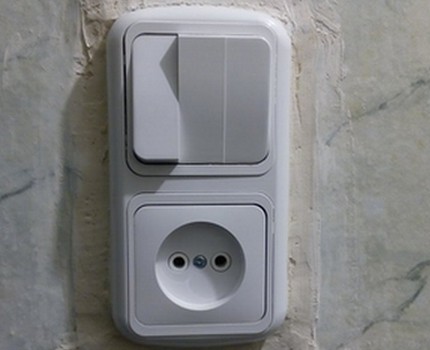
The installation of a triple switch, combined with a socket in a common housing, is justified in those situations when it is supposed to equip open wiring. Electrical safety rules strictly regulate the height of the switches and sockets - 150 cm from the floor.
For this reason, such models are installed in places where sockets are operated quite often, provided that the switches at this height are convenient to use.
Combined models received the greatest distribution at arrangement of bathrooms with placement near mirrors and bedrooms in a zone of bedside tables.
A separate subspecies distinguish triple switches of wireless design, which can be installed anywhere and placed on any surface.
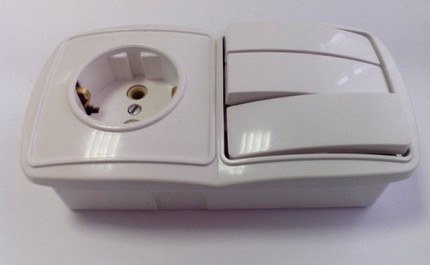
Wireless devices are equipped with two modules:
- Receiver - A relay type device integrated in a light source. When a signal is received, it closes the lighting circuit.
- Signal transmitter - the circuit breaker itself, equipped with an energy generator. When you press a key, it processes the energy pulse into a radio signal.
Such high-tech devices are expensive. Instead of the usual wiring, they use infrared or radio waves.
There are also on sale switches equipped with backlight. They are convenient in the sense that in the dark they create a light signal, which serves as a good guide for finding the device quickly.
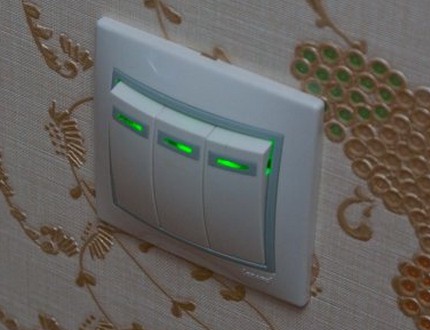
When choosing such models, it is worth paying attention to the type of lighting source. Illuminated switches do not cause trouble only when connected in a circuit with conventional incandescent lamps or their halogen counterparts.
If fluorescent lamps or LED strips are used in a circuit with such a device, then even with the switch off, they will continue to emit a light pulsating glow.
Competent selection criteria
When purchasing a triple switch, carefully inspect it, examine the physical quantities, check for a wiring diagram.
Key points to consider when choosing a product:
- Product body - it should be free from any kind of defects: burrs, dents and chips.
- Key Triggering - It should happen easily and without jamming.
- Sound effects - when each of the keys is turned on, a characteristic click should be heard.
- Core - It should also be free of burrs, and its terminals should work properly.
When planning to install a switch in a room with high humidity, you must choose a device with protection.
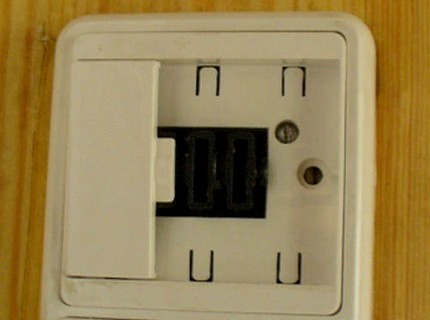
In order to simplify the installation procedure and ensure the durability of the device, preference should be given to models whose cores are equipped with screw or clamp type terminals.
During the installation of triple circuit breakers of imported production, especially Korean and Chinese products, difficulties may arise, which are worth considering in advance:
Device Connection Technology
Connecting three-key switches is practically no different from mounting technology for single and two-key analogs.
The point is that one of the supply cables is connected to the input of the switch, and cables of lighting devices are connected to the input contacts of the connection blocks. The difference is only in the total number of contacts of the involved switching groups located in the device case.
Preparatory work
The first thing to do before connecting or disassembling the three-key switch is to disconnect the switch for a while and make sure that the network is disconnected. Before starting work, you need to understand the wiring to which you plan to mount the device box.
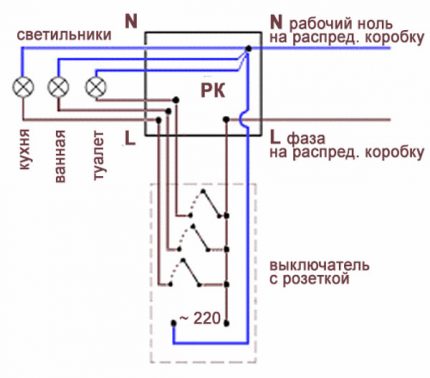
It will not be possible to connect the switch without a set of the following tools:
- voltage indicator;
- stripping tool;
- Phillips and flat head screwdrivers;
- hammer drill equipped with a crown;
- building level;
- insulating tape.
When the switch is installed internally, a socket and a small portion of gypsum or alabaster will be required to place the core of the device. To assemble the wires and connect the contacts inside the junction box - self-clamping terminal blocks.
Assembly of wires in the junction box
Two wires are supplied from the shield to the junction box.
It is easiest to determine their affiliation by the color of the braid and marking:
- "zero" - painted in blue;
- "phase" - has a brown braid.
For the reliability of the conclusions when determining the ownership of the wires, it is better to use a tester.
Six wires come from the lamps into the junction box. The task of the wizard is to connect three of them among themselves, and then connect to a working zero, coming from the shield. The remaining three wires can only be directed to the switch and docked with its outputs.
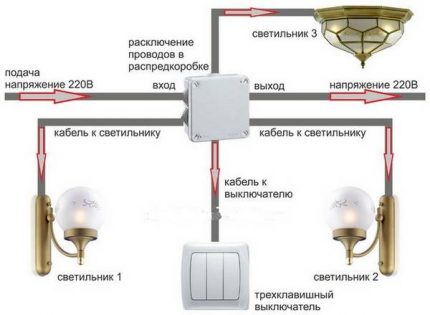
The main points to consider when assembling the wires in the junction box cavity:
- Zero supply wires are connected to all the “zeros” of powered lighting fixtures.
- The phase of the supply wire is connected to the common contact of the switch.
- The remaining three wires coming from the switch are connected to the corresponding three phase wires that came from each lighting device.
Having connected to the release one common phase for all light sources, a circuit is created in which at the moment of closure of one of the contacts of the switch, one or another lamp lights up.
Installation of a socket box in a niche
The socket is only used when installing indoor switches, the core of which half goes into the wall. The main requirement for the installation of the socket is that its edges are flush with the wall and do not protrude beyond it. Otherwise, after installing the core, the switch housing will protrude from the wall.
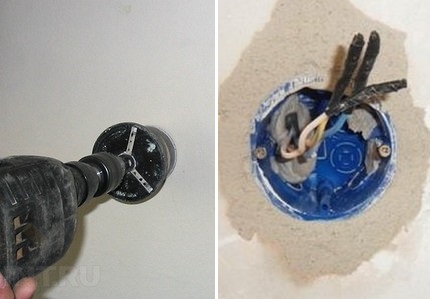
Commercially available podrozetniki can vary in color, shape and the presence of side protrusions. If the installation method is taken as the basis, then the “glasses” are divided into two types:
- For concrete - One-piece constructions that are fixed in the wall by means of plaster or alabaster.
- For drywall - designs are equipped with special paws with which they burst in the wall.
Regardless of the design, any socket is equipped with pressed-in holes through which an electric wire is inserted into the cavity of the structure.
We also recommend that you read our other material, where we spoke in detail about the technology of installing the sockets in concrete and drywall. More details - go to the link.
A "glass" with a wire inserted into it is buried in a pre-made niche, leveled with a level on the horizontal and vertical plane and fixed in the wall.
3-key switch wiring diagram
To access the triple switch mechanism, the keys are removed from the device and the decorative frame is removed. This work is not difficult to do with a flat screwdriver.
To remove the key, you just need to press it, turning it to the “off” position, and gently protrude the edge protruding from the opposite side, without applying excessive force, with a screwdriver tip.
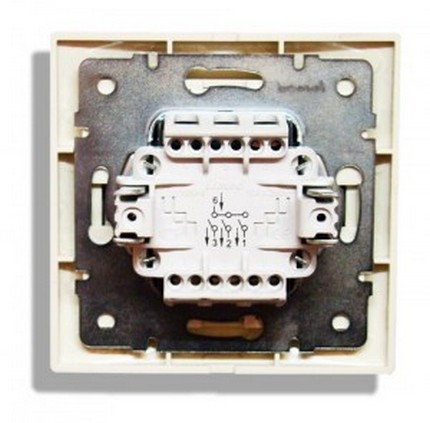
Four wires will be routed to the switch installation site.
They can be combined into a four-wire cable or be a combination in which:
- single-phase phase comes from the junction box;
- three-core, which through the distribution box delivers a phase to the connected lighting devices.
The zero wire will pass directly from the junction box to the lights, bypassing the switch.
The incoming phase is connected to the input terminal marked with an arrow, and the three outgoing terminals are connected to the output wires of the fixtures. Which output to which terminal does not play a special role. If you want a specific terminal to be responsible for this particular lamp, reconnecting the wires will not cause any special difficulties.
The wires in the mechanism are fixed by means of clamping screws. Before inserting the bare ends, it is important to ensure that the screw rods are not completely screwed into the grooves. Having brought the ends of wires cleaned from the braid into the mechanism, tighten the screws tightly. When checking the wires for removal, there should be no backlash.
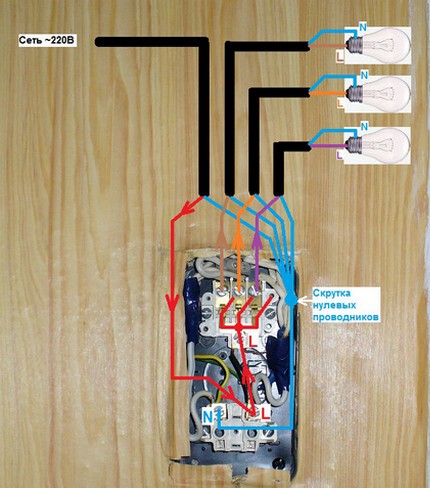
The basic rule of connecting a three-key switch circuit is that the network input phase wire is not started at the device input, but not zero. Zero network wires are connected exclusively to the "zeros" of lighting fixtures. This rule is strictly regulated by the current standard - PUE.
Some craftsmen neglect this rule, directing the phase wire to the lamp, and feeding “zero” through the switch to break. With this build option, the network will still work. But such a decision is fraught with danger during the operation of the electrical system, because even with the switch off, the wiring will still remain energized.
This is dangerous because even with the usual replacement of bulbs, a person will be at every time exposed to the risk of electric shock. And if a breakdown of insulation occurs at all, and there is no grounding of the connected lighting device, voltage will appear on the device case.
As a result, with the slightest contact with the surface of the device, an electric shock will occur.
Features of installation of combined models
The connection diagram of the switch, combined in a common housing with a socket, is somewhat different from that described above. And the main difference is the presence of an additional neutral wire laid from the junction box directly to the outlet. In this case, the output from the switch will have two double wires.
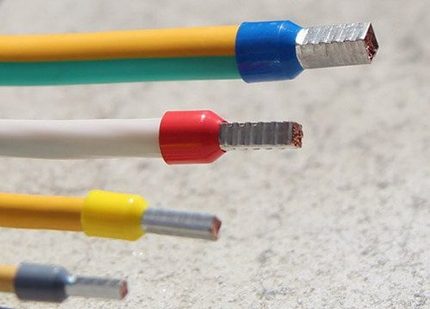
To make a safe connection of the switch with a socket, it is better to use a wire with a cross-section of 2.5 square mm. And already directly to the lighting devices from the switch, lay a cable of 1.5 squares.
At the final stage of installation, it remains only to check the correctness of the switching wires and install a decorative frame. To check the correct connection, you need to turn on the switch and apply voltage.
When you turn on the first key of the device, one lamp should light up, when you turn on the second, the next horn of the chandelier or a connected electrical appliance.
The frame is fixed with a clamping insert. You need to slightly press on it and with a little effort click on the sides.
For more information on installing combined sockets, see this article.
Conclusions and useful video on the topic
Three-way switch connection sequence:
Assembly option for a three-gang switch with a socket:
Device installation example:
By assembling the device in accordance with the wiring diagram and adhering to safety precautions during installation, you can be sure that the circuit breaker will operate without interruption for many years.
Maybe you already had to install a three-key switch yourself and you know the subtleties that we did not take into account in this article? Or have questions about the topic? Please write comments, share tips, ask questions in the block below.

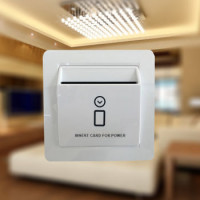 Card switch: what is it for, how to choose it and connect it correctly
Card switch: what is it for, how to choose it and connect it correctly 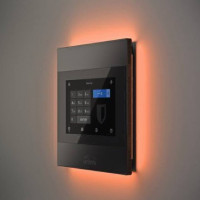 Smart switches: types, labeling, how to choose and connect correctly
Smart switches: types, labeling, how to choose and connect correctly 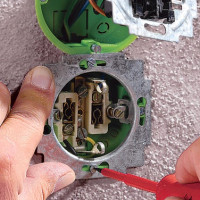 How to connect a switch with one key: rules and connection diagrams
How to connect a switch with one key: rules and connection diagrams 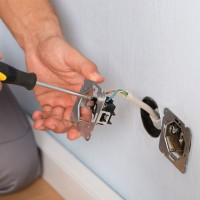 How to connect a passage switch: circuit analysis + step-by-step connection instructions
How to connect a passage switch: circuit analysis + step-by-step connection instructions 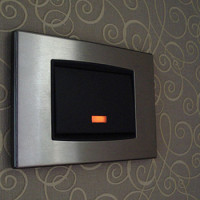 How to connect an LED switch: rules for connecting a backlit switch
How to connect an LED switch: rules for connecting a backlit switch 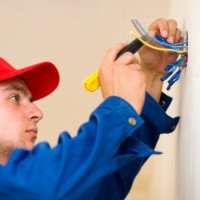 How to connect a double switch to two bulbs: schemes + connection tips
How to connect a double switch to two bulbs: schemes + connection tips  How much does it cost to connect gas to a private house: the price of organizing gas supply
How much does it cost to connect gas to a private house: the price of organizing gas supply  The best washing machines with dryer: model rating and customer tips
The best washing machines with dryer: model rating and customer tips  What is the color temperature of light and the nuances of choosing the temperature of the lamps to suit your needs
What is the color temperature of light and the nuances of choosing the temperature of the lamps to suit your needs  Replacement of a geyser in an apartment: replacement paperwork + basic norms and requirements
Replacement of a geyser in an apartment: replacement paperwork + basic norms and requirements
But when choosing switches with backlight, it is necessary to take into account the type of bulbs used in lighting. The fact is that when installing fluorescent lamps, they will periodically blink. Naturally, this does not scare users away, but it reduces the life of the bulbs themselves. That is why it is better to choose switches without such a backlight.
Very helpful information. He began to make repairs at home, the question arose about the switches. The most convenient option was a three-key model. If I dealt with conventional switches before, then I encountered this type for the first time, and, frankly, was confused. Everything is described in detail and easily accessible, in a couple of hours I completely figured out everything and was able to put the switch on.